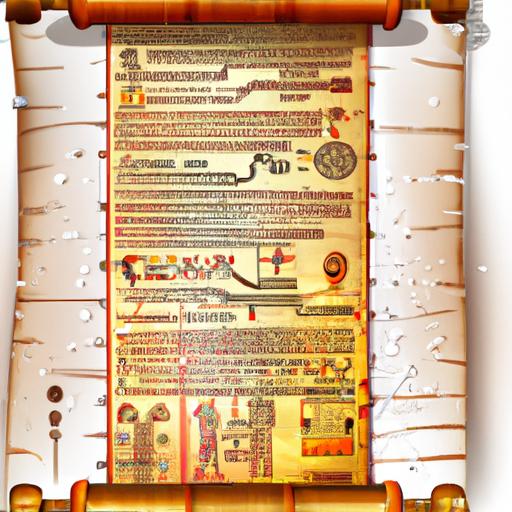Who Invented Paper? A Comprehensive Overview of the History of Paper
Table of Contents
Paper is a ubiquitous material that we use every day, yet many people don’t know the story of its invention. In this article, we’ll explore the history of paper, including its early origins and the people who invented it. We’ll also take a look at how paper evolved over time and its impact on society.
Early History of Paper

The invention of paper dates back to ancient times, and the earliest known examples of paper were found in ancient Egypt. Ancient Egyptians used a material called papyrus, which was made by slicing thin strips from the stem of the papyrus plant and then laying them in a crosshatch pattern. The strips were then pressed and dried, resulting in a flat, durable writing surface.
Papyrus was used for a variety of purposes, including writing, art, and even clothing. Papyrus was especially valued for its durability, as it could last for centuries when stored in dry conditions. The use of papyrus spread throughout the ancient world, with many civilizations using it as their primary writing material.
Despite its usefulness, papyrus had some drawbacks. It was difficult to produce in large quantities, and the quality of the material could vary depending on the quality of the plant used. These limitations led to the development of a new material that would revolutionize the way we write and communicate: paper.
Chinese Invention of Paper
While the ancient Egyptians were using papyrus, another civilization was developing a new material that would change the world: the Chinese. In the 2nd century BCE, a Chinese court official named Cai Lun invented a new material made from the bark of the mulberry tree, silk fibers, and other plant materials. This new material was easier to produce than papyrus and was also more versatile, as it could be used for a variety of purposes.
Cai Lun’s invention was initially used for writing, but it soon became popular for other uses, such as packaging, money, and even toilet paper. The papermaking process in ancient China was a closely guarded secret, and the Chinese used their knowledge of papermaking to gain an advantage in trade and commerce. The Chinese eventually shared their knowledge of papermaking with other civilizations, and the use of paper spread throughout the world.
Chinese Invention of Paper (Continued)
Cai Lun’s invention of paper was a significant development in human history, and it changed the way we communicate and record information. The papermaking process in ancient China involved boiling the mulberry bark and other plant fibers in water until they turned into a pulp. The pulp was then spread out on a fine mesh screen and pressed to remove excess water. The resulting sheets of paper were then dried and cut into the desired size.
The Chinese were able to produce high-quality paper in large quantities, and they quickly realized the value of their invention. Paper became a crucial part of Chinese society, and it was used for everything from writing and painting to packing and wrapping goods. The Chinese also used paper money as early as the 7th century, and it became the primary form of currency in China for centuries.
Spread of Papermaking
The knowledge of papermaking eventually spread beyond China, and other civilizations began to adopt the practice. One of the earliest adopters of papermaking was the Islamic world, where paper mills were established in the 8th century. The Islamic world also played a significant role in the development of paper, as they introduced new materials and techniques, such as the use of linen and cotton fibers.
The introduction of paper to Europe was a gradual process, and it wasn’t until the 12th century that paper mills began to appear in Spain and Italy. The use of paper spread quickly throughout Europe, and it soon replaced parchment and vellum as the primary writing material. The widespread availability of paper also helped to promote literacy and education, as books and other written materials became more affordable and accessible to the general public.
In conclusion, the invention of paper was a significant development in human history, and it changed the way we communicate and record information. From its early origins in ancient Egypt to the invention of paper in China, and its spread throughout the world, paper has played a crucial role in shaping the modern world. Today, we continue to rely on paper for everything from books and newspapers to packaging and printing, and it remains an essential material in our daily lives.
Improvements to Papermaking
Over time, papermaking techniques continued to evolve, leading to significant improvements in paper quality and production. One of the most significant advancements in papermaking was the development of the Fourdrinier machine in the early 19th century. This machine revolutionized the papermaking process, allowing for the production of large quantities of high-quality paper quickly and efficiently.
Other improvements to papermaking included the development of new paper types and the use of chemicals to improve paper strength and durability. In the 20th century, the use of computers and automation further improved the papermaking process, making it even more efficient and cost-effective.
Conclusion
The invention of paper has had a profound impact on society, revolutionizing the way we communicate and share information. The creation of paper made written communication more accessible to the masses, leading to advancements in literature, science, and technology.
The inventors of paper, including Cai Lun and the early papermakers of ancient Egypt, deserve appreciation for their groundbreaking work. Without their ingenuity and creativity, we may never have had the ability to share our ideas and thoughts with others through the written word.
Today, paper remains an essential material in our daily lives, from books to newspapers to packaging materials. As we move towards a more digital world, it’s important to remember the history of paper and the role it has played in shaping our society.

